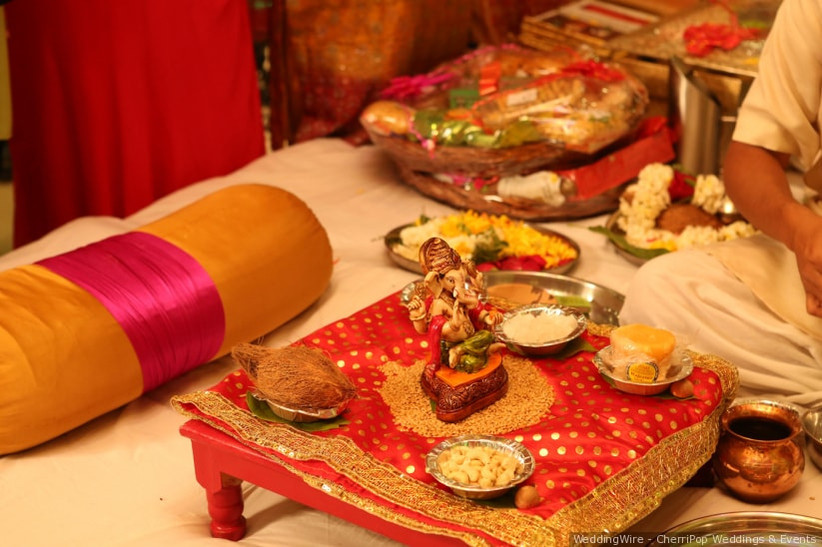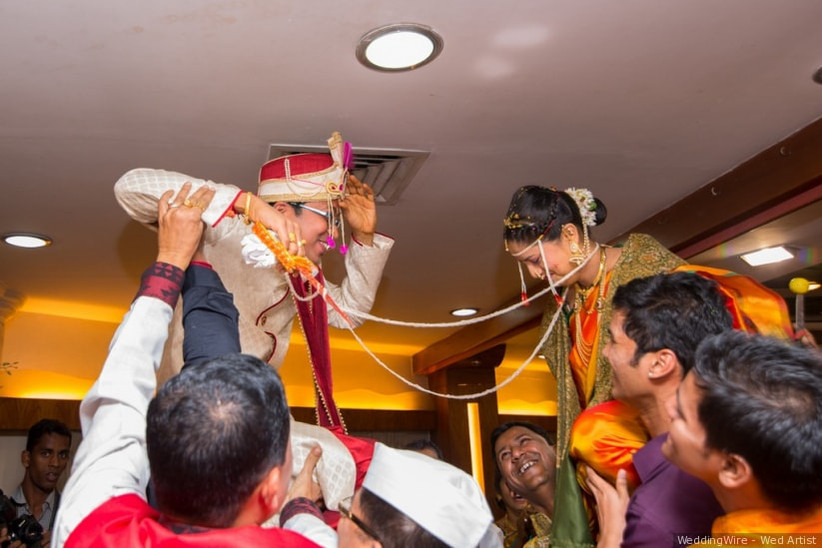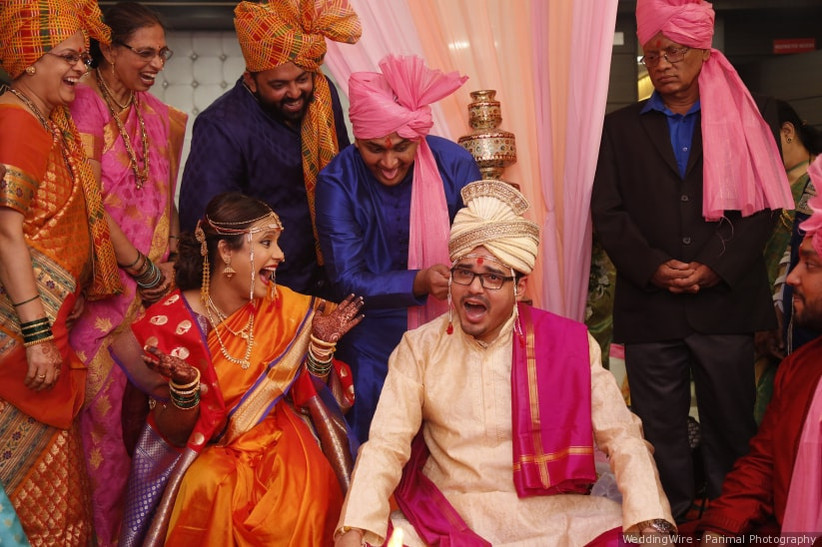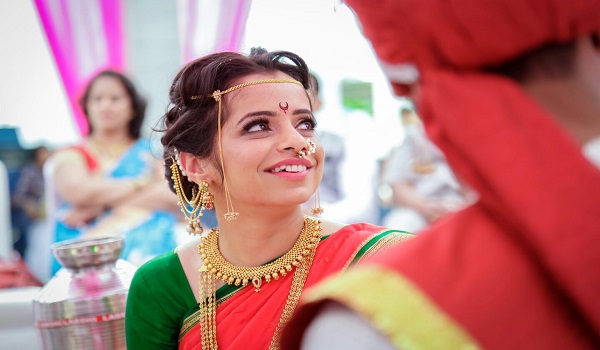Redefining the term ‘simple yet beautiful’…that’s Maharashtrian wedding for you. In this guide, we give you the complete list of pre-wedding, wedding day, and post-wedding Maharashtrian wedding rituals.
Free from unnecessary pre-wedding rituals that are free from spiritual significance, the wedding rituals portray the core values of the Maharashtrian values. However, don’t think it is a formal affair. Marathi weddings are enthralling with colors and amazing rituals that will leave you with a memorable experience.
Free from unnecessary pre-wedding rituals that are free from spiritual significance, the wedding rituals portray the core values of the Maharashtrian values. However, don’t think it is a formal affair. Marathi weddings are enthralling with colors and amazing rituals that will leave you with a memorable experience.
Matchmaking and Horoscope
The first step to traditional Maharashtrian marriage is matchmaking. Known as Lagnaach Bedior, it means finding a suitable match. Regardless you met at an online matrimonial site or arranged by priest or friends/family, matching the horoscopes is still prevalent. Nowadays, as many people upload horoscopes along with their bio on matrimonial profile, it makes things easier to find out an ideal partner by a simple click.
Pre-Wedding Rituals
Sakhar Puda
Sakhar Puda is one of the first rituals that initiates the beginning of the wedding process. It is similar to the engagement ceremony. Held few days before the wedding, the two families gather where the bride is given a saree, jewelry with a packet of sugar (known as Sakhar Puda) by the groom’s mother as a sign of her acceptance into the family.
Muhurt Karane
One the day of the Sakhar Puda, the priest checks both the horoscopes of the boy and the girl and finalizes an auspicious date and time for the wedding. Once the marriage date is finalized, another auspicious date is fixed to commence the wedding preparations. On this auspicious date, five married women or “Suhasanie” are invited. These women pound turmeric or Halkund using an iron pestle tied with mango leaves. They also roll out Papads and make Sandage (pulses soaked and ground which is mixed with spices and later dried under the sun). This is another pre-wedding activity of Muhurt Karane. After this ritual, shopping for the wedding begins. The bride’s side holds a Rukhvat by decorating the home and exhibiting bridal lehengas, sarees, jewels and ornaments, kitchen utensils, sweet delicacies and many other bridal trousseaus.

Wedding Invitations
Needless to say, both the sides print the wedding invitations. The first wedding invitation is always kept for Pooja in front of Lord Ganesha to seek his blessings.
Kelvan
This ritual is conducted a couple of days before the wedding. The respective family of the bride and the groom conducts puja to their Kuldevta (family deity) with their relatives and friends in attendance. This ritual is called Kelvan. The ceremony is then followed by a meal to the close family and relatives who attend the function.
Halad Chadavane
The Haldi Ceremony, it takes place on the day before the wedding. The five married women who pound the turmeric during the Muhurt Karane ritual apply the Haldi paste on the head, shoulders, hands and feet of the bride as well as the groom using mango leaves. The ritual is conducted in the groom’s house first after which the remaining turmeric paste is sent to the bride’s place to be applied.
Wedding Day Rituals
Ganpati Puja and Devdak
The wedding day starts by worshipping Lord Ganesha and seeking his blessings for successful completion of the wedding and happiness for the couple and pray that their lives are free from any obstacle. The Kuldevata is then invoked where the wedding is to take place during the Devdak ritual.

Punya vachan and Seeman Puja
The bride’s parents take her to the Mandap and ask everyone to bless their daughter. As the groom and his family arrive at the wedding venue, the bride’s mother washes the groom’s feet, applies a Tilak on his forehead and does an Aarti.
Gurihar Puja
The bride dressed up in traditional Marathi wedding attire worships Goddess Parvati who is placed on a mound of rice. The maternal uncle hands over some rice which she offers to the Goddess to seek her blessings for a happy and prosperous life.
The Antarpat
The groom appears at the Mandap with his head covered by a traditional turban. He wears the Mundavalya and sits at his designated wedding spot at the Mandap. A curtain is held which prevents him from seeing the bride. This cloth is known as the Antarpat.
The Sankalp
The priest chants the Mangalashtakas, or sacred wedding vows. The bride is led to the mandap by her maternal uncle. At an auspicious time, the Antarpat is removed and the couple sees each other and Varmalas as they are showered with Akshata or whole rice.

The Kanyadan
An emotional moment between the father and the bride as he gives her daughter away to the groom to start a new life. The groom accepts his blessings and promises to love and respect her.
Lajahoma
In this ritual, the bride and the groom are seen as avatars of Lord Vishnu and Goddess Lakshmi. Keeping the sacred fire as the witness of their marriage, the couple ties a turmeric thread on each other’s hands. This ritual is called as Kankan bandhane. As a final touch, the groom ties the Mangalsutra around the bride’s neck and applies vermillion on her forehead. The bride in return applies a sandalwood tilak on the groom’s forehead.

The Saptapathi
As they chant the seven wedding vows, the couple circumambulates around the sacred fire seven times.
The Karmasamapti
To conclude the wedding, the couple performs the Laxmi Pujan in front of the holy fire till it is extinguished. The father of the bride lightheartedly twists the groom’s ear to remind him of his marital duties. The couple gets up from the Mandap and seeks blessings from all the elders present.

Post Wedding Rituals
The Varat ritual
Varat means the farewell of the bride from her parents’ home as she begins to start her new life with her husband. The groom picks up the silver idol of Goddess Parvati from the Gaurihar Puja. The Varat ritual is usually a procession that follows the bride to her husband’s home.
The Grihapravesh
The groom’s mother officially welcomes the newlyweds to her new home. She conducts Aarti and washes their feet with milk and water. The bride is then asked to enter the house by knocking down a Kalash of rice placed at the entrance. The couple enters the house by placing their right foot forward.
The Reception
The final celebration party is organized where the bride and the groom are introduced to all the guests. The bride wears saree and jewelry gifted to her from the groom’s side while the groom dons an attire which the bride’s parents gifted him.
Wedding Attires of the bride and groom
The Maharashtrian Groom
The traditional Maharashtrian groom’s wedding outfit is white or beige cotton kurta which is paired with a white thin bordered Kanche or Dhoti. There is also a red/gold colored decorative stole which the groom wraps on his shoulders in style. He also wears a turban on his head called Pheta or a traditional white Gandhi-style cap.

The Maharashtrian Bride
The bride wears a colorful silk saree that has the intricate gold borders in typical Maharashtrian Dhoti style. The preferred color combinations are yellow or marigold with green or purple borders. Usually, two kinds of sarees are worn in Marathi wedding – six yards – Paithani or nine yards – Navari. The Maharashtrian bride jewellery includes green glass bangles, Mangalsutra with two hollow gold cups at the center, Thusi or their traditional necklace, Maharashtrian armlets and a moon-shaped Bindi.
Both the bride and the groom wear a unisex headband called ‘Mundavalya’. It includes two strings of pearls tied horizontally to their headband as two lines of pearls hang down from the headband near the ears.
Simple, graceful, traditional yet colorful and full of life – the Maharashtrian wedding rituals carry a flavor of their own.
